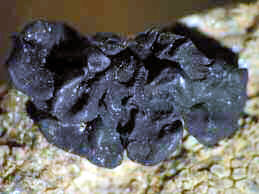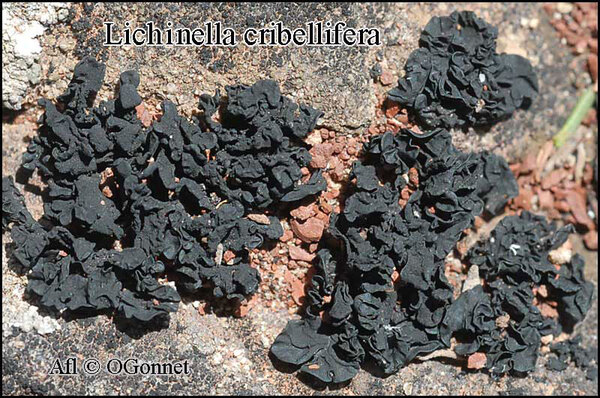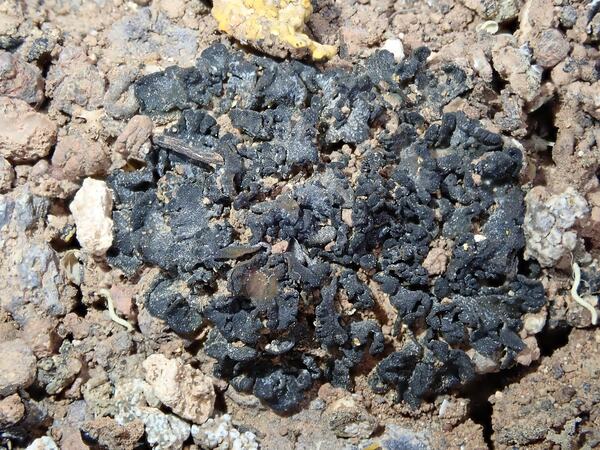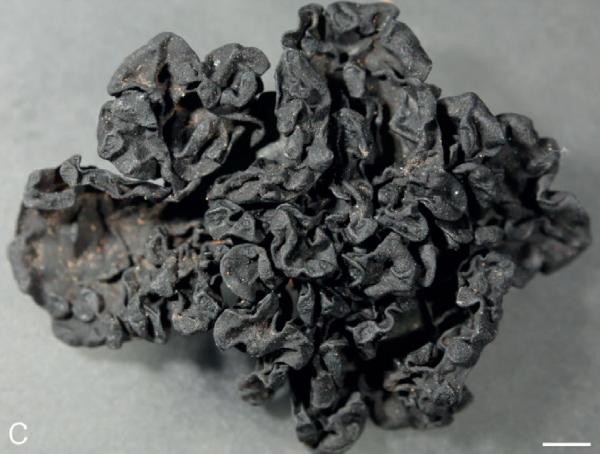Lichinella cribellifera (Nyl.) P.P. Moreno & Egea
Cryptogamie, Bryol. Lichénol., 13: 243, 1992. Basionym: Omphalaria cribellifera Nyl. - Flora, 67: 387, 1884.
Synonyms: Gonohymenia cribellifera (Nyl.) Henssen; Omphalaria granitica Samp.; Rechingeria cribellifera (Nyl.) Servít; Rechingeria granitica (Samp.) Poelt; Thyrea cribellifera (Nyl.) Zahlbr.
Distribution: C - Tosc (Pišút 1997), Sar.
Description: Thallus small-foliose to squamulose-umbilicate, gelatinous when wet, black, usually smooth in upper part, with conspicuous radial folds and ridges on lower surface, (125-)200-400 µm thick, the squamules up to 30 mm wide, forming (5-)10-25 mm wide, polyphyllous rosettes, deeply lobulate, the lobules flat, rounded at tips, 2-3(-4) mm wide, adpressed or slightly ascending especially when fertile; lower surface attached by a central holdfast and sparse rhizohyphae. Thallus 0.25-0.4 mm thick, the outer part 50-110 µm thick, formed by 1.5-2.5 µm thick, mainly anticlinally oriented hyphae with cylindrical to isodiametrical cells, enclosing the photobiont cells, the medullary part of loosely arranged, 1-1.5 µm thick hyphae with cylindrical cells, lacking photobionts. Apothecia thallinocarps, hemiangiocarpous, the ascogonia arising freely beneath the thallus surface, sunken in thallus and difficult to recognize unless when wet, marginal to submarginal, up to 4 mm across (usuallly much less), round to irregularly shaped, with a slightly flat to convex, often fissured disc, without a well differentiated thalline margin. Proper exciple indistinct, up to 5 µm wide; epithecium brownish, 15-25 µm high, mostly continuous; hymenium 50-80(-100) µm high, finally subdivided into 30-60 µm wide, well-separated compartments by intrusions of wedge-shaped, sterile thalline tissue, covered by a continuous layer of sterile tissue separated only by the pore-like discs of the partial hymenia, K/I+ blue turning wine-red; paraphyses 2-2.5 µm thick, weakly capitate; subhymenium discontinuous, 25-40 µm high, K/I+ blue. Asci 16-32-spored, subcylindrical to obclavate, prototunicate, with a thin, one-layered, non-amyloid wall, an amyloid external apical cap, and passive spore discharge via apical rupturing, Lichina-type. Ascospores 1-celled, hyaline, ellipsoid, (5-)6-9(-10) x 2-4(-5) µm. Pycnidia mainly marginal, globose to pyriform, immersed, unilocular, 80-120 µm wide. Conidia ellipsoid to fusiform, 2-5 x 1-2 µm. Photobiont cyanobacterial, chroococcoid, with a few cells measuring 5-10 x 4-7 µm, penetrated by haustoria and surrounded by a brownish gelatinous sheath. Spot tests: all negative. Chemistry: without lichen substances.
Note: on steeply inclined faces of siliceous rocks, especially in seepage tracks, usually below the montane belt; probably more widespread in Tyrrhenian Italy.
Growth form: Foliose, umbilicate
Substrata: rocks
Photobiont: cyanobacteria, coccaceous (e.g. Gloeocapsa)
Reproductive strategy: mainly sexual
On otherwise dry surfaces with short periods of water seepage after rain
Commonnes-rarity: (info)
Alpine belt: absent
Subalpine belt: absent
Oromediterranean belt: absent
Montane belt: absent
Submediterranean belt: absent
Padanian area: absent
Humid submediterranean belt: very rare
Humid mediterranean belt: rare
Dry mediterranean belt: absent

Predictive model
Herbarium samples

Courtesy Danièle et Olivier Gonnet - Source: https://www.afl-lichenologie.fr/Photos_AFL/Photos_AFL_L/Lichinella_cribellifera.htm
France, session AFL 2010 - Hérault

Harrie Sipman http://www.bgbm.fu-berlin.de/sipman/Zschackia/AegeanLichens/CaloplacaAC.htm - As Caloplaca oasis

Harrie Sipman – Source http://www.bgbm.fu-berlin.de/sipman/Zschackia/AegeanLichens/CaloplacaAC.htm - As Caloplaca oasis
Growth form: Foliose, umbilicate
Substrata: rocks
Photobiont: cyanobacteria, coccaceous (e.g. Gloeocapsa)
Reproductive strategy: mainly sexual
On otherwise dry surfaces with short periods of water seepage after rain
Commonnes-rarity: (info)
Alpine belt: absent
Subalpine belt: absent
Oromediterranean belt: absent
Montane belt: absent
Submediterranean belt: absent
Padanian area: absent
Humid submediterranean belt: very rare
Humid mediterranean belt: rare
Dry mediterranean belt: absent

Predictive model
| Herbarium samples |

Courtesy Danièle et Olivier Gonnet - Source: https://www.afl-lichenologie.fr/Photos_AFL/Photos_AFL_L/Lichinella_cribellifera.htm
France, session AFL 2010 - Hérault

Harrie Sipman http://www.bgbm.fu-berlin.de/sipman/Zschackia/AegeanLichens/CaloplacaAC.htm - As Caloplaca oasis

 INDEX FUNGORUM
INDEX FUNGORUM
 GBIF
GBIF




